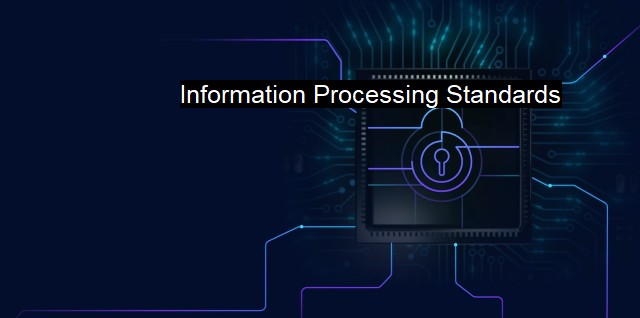What are Information Processing Standards?
The Importance of Information Processing Standards in Ensuring Effective Cybersecurity for Individuals and Organisations
Information Processing Standards (IPS) are a set of protocols that regulate the exchange, processing, and communication of information within a digital environment. They have a pivotal role in the realm of cybersecurity and antivirus software, where preserving the integrity, confidentiality, and availability of information stands as top priority. The IPS represents the backbone of any system or organizational structure that relies extensively on digital operations, and their implementation is an essential preventive measure against potential cyber threats and disruptions.In the cybersecurity context, implementing IPS allows for the systematization of security controls, ensuring that standardized procedures and barriers are in place. Following IPS ensures that every potential gateway a hacker might use, such as malicious websites, infected emails or software vulnerabilities, is securely sealed off. For instance, guidelines provided in the IPS may direct that an encrypted connection must be used at all times, to prevent unauthorized interception of data, or they may dictate strict password complexities, to reduce the chance of a brute force attack transpiring.
At its core, the IPS serves to establish and maintain the mechanisms by which security goals can be met, supplemented by the use of antivirus software. Antivirus software acts as a sort of digital immune system, detecting, isolating, and eliminating any threats to a computer. The IPS governs this dynamic, providing the rules the antivirus software follows in its search for potential threats.
Implementing a stringent IPS can facilitate rigorous antivirus scrutiny and ensure that any irregularities are addressed rapidly and efficiently. This works to secure an immediate line of defense, which is essential to maintaining the overall health of the technological ecosystem and to support business continuity.
IPS mitigate the risks of other harmful repercussions that could have cost implications from lawsuits stemming from data breaches or loss of data and privacy. It also aids in ensuring the regulatory compliance demanded by various legal bodies and International Standards Organizations, lending credibility to a system’s resilience against external threats.
For instance, running antivirus software without employing standardized processing guidelines would be the cybersecurity equivalent of applying a band-aid to a deep wound. cybersecurity and its accompanying antivirus component operate best when fuelled by informed, standardized, and meticulously enacted procedural frameworks—precisely what the IPS delivers.
It’s important to note that while IPS are indispensable within a security strategy, conducting regular updates and checks to assess the efficacy of these controls remain as important. Why? Cyber threats evolve fast. Outdated IPS present hackers with an open invite they’ll readily exploit, turning any given security system devoid of up-to-date protective norms into a breeding ground for malware and data breaches.
In the context of cybersecurity and antivirus measures, it is absolutely crucial that the appropriate Information Processing Standards (IPS) are implemented and kept current. This cannot be seen as an option but rather an institutionalized duty within the digital environments we interact with on a daily basis. The IPS not only serves as an invaluable tool for maximizing security but also allows organizations to demonstrate their commitment to optimally safeguarding their system’s operational resilience and most significantly, their users’ data integrity.
But, the piece of advice to take note of is this: while rules in the form of IPS can guide and govern the use of cybersecurity tools aiming to fortify digital territories, they can merely aid and not outrule the intrinsic human capacity for diligence, prudence and ingenuity in the face of adversity. And in the dynamic, ever-evolving landscape of cybersecurity, these indeed stand as valuable markers of first line of defense – reinforcing the strategic fort fortified by ANSI-established IPS.

Information Processing Standards FAQs
What are information processing standards?
Information processing standards are a set of guidelines and criteria that ensure the confidentiality, integrity, and availability of information processed by a system or application. These standards help to establish a secure and reliable computing environment, especially in the context of cybersecurity and antivirus.Why are information processing standards important for cybersecurity?
Information processing standards play a critical role in maintaining the security of a computer system or network. By adhering to these standards, organizations can ensure that their information is protected from unauthorized access, disclosure, and modification. Additionally, these standards help to prevent attacks and reduce the impact of security breaches.What are some examples of information processing standards in cybersecurity?
Some of the commonly used information processing standards in cybersecurity include ISO 27001, NIST SP 800-53, PCI DSS, HIPAA, and GDPR. These standards provide a comprehensive framework for managing security risks and protecting sensitive data. They cover various aspects of information security, such as access control, network security, incident response, and data protection.How do organizations comply with information processing standards?
To comply with information processing standards, organizations need to implement a security management program that includes policies, procedures, and controls to manage security risks. They also need to conduct regular security assessments and audits to identify vulnerabilities and prioritize remediation efforts. In addition, organizations need to provide security awareness training to employees and ensure that vendors and partners also comply with the relevant standards.| | A | | | B | | | C | | | D | | | E | | | F | | | G | | | H | | | I | | | J | | | K | | | L | | | M | |
| | N | | | O | | | P | | | Q | | | R | | | S | | | T | | | U | | | V | | | W | | | X | | | Y | | | Z | |
| | 1 | | | 2 | | | 3 | | | 4 | | | 7 | | | 8 | | |||||||